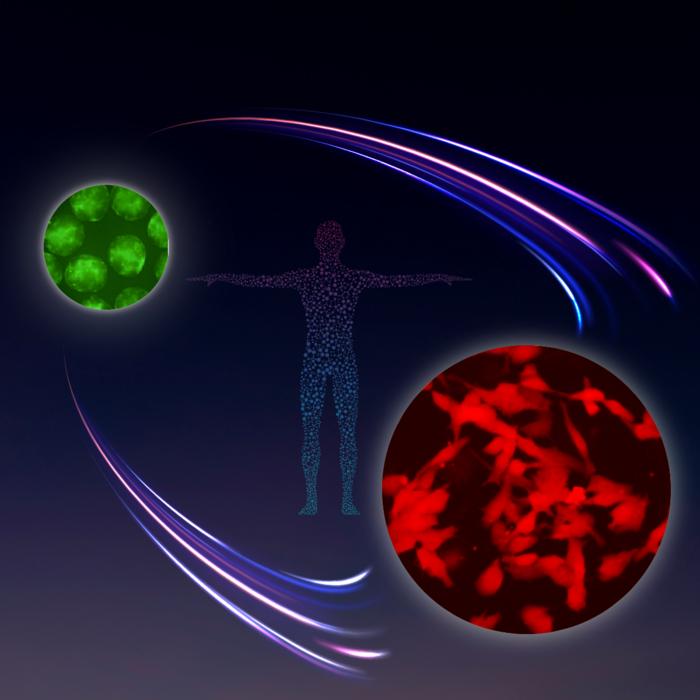KYOTO, Japan – May 20, 2024

Credit: WPI-ASHBi/Kyoto University
KYOTO, Japan – May 20, 2024
Infertility affects approximately 1 in 6 people in their lifetime worldwide according to the World Health Organization (WHO). Infertility —as defined by the American Society for Reproductive Medicine (ASRM)— is a disease, condition, or status characterized by “the inability to achieve a successful pregnancy based on a patient’s medical, sexual, and reproductive history, age, physical findings, diagnostic testing, or any combination of those factors” or requiring medical intervention such as the use of mature donor gametes “to achieve a successful pregnancy either as an individual or with a partner”. Although assisted reproductive technologies (ARTs), such as in vitro fertilization (IVF), have had a tremendous impact in treating certain forms of infertility —not all forms of infertility (as defined by the ASRM) can be targeted with existing strategies.
Recently, one powerful technology has emerged —known as human in vitro gametogenesis (IVG)— using pluripotent stem cells (PSCs) such as induced pluripotent stem cells (iPSCs) from patients, to generate human germ cells with the capacity to potentially give rise to mature gametes in culture, offering a gateway to treating all form of infertility —independent of gender. Nevertheless, human IVG research still remains in its infancy, with the current goal being to reconstitute the complete process of human gametogenesis. To date, one major challenge has been to recapitulate in the founder population of germ cells, or the human primordial germ cells (hPGCs), a hallmark event known as epigenetic reprogramming —in which the inherited parental “memory” of cells, present on its DNA, is reset/erased— that is required for proper germ cell differentiation.
Now, in a study published in Nature, researchers at the Institute for the Advanced Study of Human Biology (WPI-ASHBi) in Kyoto University, led by Dr. Mitinori Saitou, identify robust culture conditions necessary to drive epigenetic reprogramming and germ cell differentiation into precursors of mature gametes, the mitotic pro-spermatogonia and pro-oogonia with the capacity for extensive amplification, achieving a new milestone for human IVG research.
Previous work from Saitou’s team and other groups were successful in generating so-called human primordial germ cell-like cells (hPGCLCs) from PSCs in vitro, which recapitulated several fundamental features of hPGC, including the capacity to propagate. However, these hPGCLCs were unable to undergo epigenetic reprogramming and differentiation. Although such limitations could be bypassed by aggregating hPGCLCs with mouse embryonic (non-germinal) gonadal cells to mimic the microenvironment of the testis/ovary, thereby effectively “reconstitute” the tissue(s). However, this process is highly inefficient (with approximately only 1/10th of cells differentiating). Furthermore, the introduction of non-human cells is neither ideal nor practical from a clinical application perspective. Therefore, in order to achieve the ultimate goal of human IVG research, it is essential to identify the minimal culture conditions necessary to generate mature human gametes.
In their new study, Saitou and colleagues conducted a cell culture-based screen to identify potential signaling molecules required to drive epigenetic reprogramming and differentiation of hPGCLCs into mitotic pro-spermatogonia and oogonia. Surprisingly, the authors found that the well-established developmental signaling molecule, bone morphogenetic protein (BMP), played a crucial role in this reprogramming and differentiation process of hPGCLCs.
“Indeed, considering that BMP signaling already has an established role in germ cell specification, it was highly unexpected that it also drives hPGCLC epigenetic reprogramming” comments Saitou.
Remarkably, these hPGCLC-derived mitotic pro-spermatogonia/oogonia not only displayed similarities in gene expression and epigenetic profiles to that of actual hPGC differentiation in our bodies, but also underwent extensive amplification (over 10 billion-fold). “Our approach enables near-indefinite amplification of mitotic pro-spermatogonia and oogonia in culture and we now also have the ability to store and re-expand these cells as needed” says Saitou.
The authors also revealed the potential mechanisms of how BMP signaling may be leading to epigenetic reprogramming and hPGCLC differentiation. “BMP (signaling) appears to be attenuating the MAPK/ERK (mitogen-activated protein kinase/extracellular-regulated kinase) signaling pathway and both the de novo and maintenance activities of DNMT (DNA methyltransferase), but further investigation will be necessary to determine the precise mechanism and whether this is direct or indirect”, explains Saitou.
“Our study represents not only a fundamental advance in our understanding of human biology and the principles behind epigenetic reprogramming in humans but also a true milestone in human IVG research” says Saitou.
Saitou comments, “although many challenges remain and the path will certainly be long, especially when considering the ethical, legal, and social implications associated with the clinical application of human IVG, nevertheless, we have now made one significant leap forward towards the potential translation of IVG into reproductive medicine.”
These findings were published in Nature on May 20th 2024.
###
By
Spyros Goulas, PhD
Scientific Advisor
Institute for the Advanced Study of Human Biology (ASHBi)/Kyoto University
Email: goulas.spyros.3n@kyoto-u.ac.jp
Lead Principal Investigator
Mitinori Saitou, MD PhD
Institute for the Advanced Study of Human Biology (ASHBi)/Kyoto University
Email: saitou@anat2.med.kyoto-u.ac.jp
###
About Institute for the Advanced Study of Human Biology (ASHBi), Kyoto University
What key biological traits make us ‘human’, and how can knowing these lead us to better cures for disease? ASHBi investigates the core concepts of human biology with a particular focus on genome regulation and disease modeling, creating a foundation of knowledge for developing innovative and unique human-centric therapies.
About the World Premier International Research Center Initiative (WPI)
The WPI program was launched in 2007 by Japan’s Ministry of Education, Culture, Sports, Science and Technology (MEXT) to foster globally visible research centers boasting the highest standards and outstanding research environments. Numbering more than a dozen and operating at institutions throughout the country, these centers are given a high degree of autonomy, allowing them to engage in innovative modes of management and research. The program is administered by the Japan Society for the Promotion of Science (JSPS).
Journal
Nature
Method of Research
Experimental study
Subject of Research
Cells
Article Title
In Vitro Reconstitution of Epigenetic Reprogramming in the Human Germ Line.
Article Publication Date
20-May-2024



